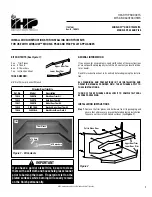
REV. B Page 7
Flat Pan - Match Throw Fire Pits
VENTILATION FOR NON-COMBUSTIBLE ENCLOSURE
Fire pits are subjected to many outdoor elements such as rain,
snow, wind, heat or cold.
A minimum of 18 square inches
(two opposite sides) of cross ventilation is required to
keep the components in good working order.
Use Fig. 4 as
guide to assist to incorporate proper ventilation.
HIGH ELEVATION INSTALLATION
This appliance is listed for elevations from 0- 4500 feet in
Canada and the U.S. If elevation exceeds 4500 feet it may be
necessary to decrease the input rating by changing the
existing burner orifice to a smaller size. Input should be
reduced 4% for each 1000 feet beyond the 4500 feet above
sea level. Check with your local gas utility for assistance in
determining the proper orifice in your location. In some cases
the heating value may already be reduced and downsizing the
orifice may not be necessary.
Fire Pit
Enclousure
(2) 6”x12”
Vents
Examples of Cross Ventilation
2- Firegear 6 x12 vents
(Model # VENT-KIT-6X12)
Cross Flow Ventilation
(Min. 18 Sq. In. Per Side)
Fig. 4
Cross ventilation example
PREPARING A NON-COMBUSTIBLE STRUCTURE
REQUIREMENTS
1. Only non-combustible materials should come in direct contact with any part of the fire pit. Underneath area should
be non-combustible or a flat level combustible surface according to the clearances specified in this manual.
2. Refer to the NFPA54 (National Fuel Gas Code) for proper pipe sizing. Determine the size of the fire pit you are
preparing to install (Refer to page 8).
3. You must provide a rectangular opening cutout to place the fire pit into the non-combustible enclosure. Refer to
Table 1, dimension A.
4. Follow the local code requirements for the gas type being used. This fire pit should be installed in accordance with
local codes and ordinances or in the absence of local codes, with the latest National Fuel Gas Code, ANSI Z223.1
NFPA54 or CSA B149.1, Natural and Propane Installation Code in Canada.
5. Fire pits create high temperatures, it is very important to have any combustibles at a safe distance.
6. CAUTION: A minimum of 18 square inches of cross ventilation (opposite side) is required to keep the
enclosure dry. See Fig. 4.
7. These products are
designed for outdoor use only
. Not approved for any indoor use.
8. This fire pit is designed to have Firegear Outdoors lava rock or glass media completely covering the burner tube,
so that the burner is not visible. Do not cover more than 1” above the top of burner. Use lava rock a minimum of 1”
diameter as a base to fill the burner pan. DO NOT USE STONE OR RIVER ROCK.
9. Gas lines and fittings must be installed in to the non-combustible structure. All gas connections must be leak tested
before installation of the fire pit. Soapy water leak detection is required before regular use of the fire pit.
10. Do not use media that will absorb moisture over time and will not release this moisture quickly. Moisture can boil in
this material and can rapidly break apart and cause damage or personal injury. See Caution on bottom of page 3.
11. Never leave any combustible material on top of the fire pit. This could cause unsafe operation of this system and
damage to the component that will not be covered under our warranty.
13. Ensure proper water drainage is also incorporated into the fire pit enclosure.
INSTALLATION OF FIRE PIT INTO AN APPROVED ENCLOSURE








































